Effect of High Current Pulsed Electron Beam (HCPEB) on the Organization and Wear Resistance of CeO2-Modified Al-20SiC Composites
Abstract
1. Introduction
2. Materials and Methods
2.1. Material Preparation
2.2. HCPEB Treatment
2.3. Microstructure Characterization and Performance Analysis
3. Results
4. Results and Discussion
4.1. Results
- (1)
- The results of GIXRD analysis showed that the rapid melting and solidification processes triggered by the HCPEB treatment led to selective orientation of the matrix and selective growth of Al(111) grains in the modified layer.
- (2)
- SEM results showed that the presence of rare earth elements effectively eliminated defects such as porosity.
- (3)
- Hardness tests showed that the addition of rare earth Ce increased the average microhardness of the matrix by 159.16%.
- (4)
- The friction coefficient showed a reduction of 87.18% with the synergistic effect of CeO2 and HCPEB.
4.2. Discussion
Author Contributions
Funding
Institutional Review Board Statement
Informed Consent Statement
Data Availability Statement
Acknowledgments
Conflicts of Interest
References
- Li, L.; Ning, Z.; Huang, W.; Liao, L.; Zheng, Y.; Zhuang, K.; Lan, S.; Zhang, Y.; Yao, R. In-situ fabrication of lightweight SiC(Al, rGO) bulk ceramics derived from silicon oxycarbide for aerospace components. J. Alloys Compd. 2021, 869, 159297. [Google Scholar] [CrossRef]
- Liu, Q.; Wang, F.; Qiu, X.; An, D.; He, Z.; Zhang, Q.; Xie, Z. Effects of La and Ce on microstructure and properties of SiC/Al composites. Ceram. Int. 2020, 46, 1232–1235. [Google Scholar] [CrossRef]
- Ozben, T.; Kilickap, E.; Çakır, O. Investigation of mechanical and machinability properties of SiC particle reinforced Al-MMC. J. Mater. Process. Technol. 2008, 198, 220–225. [Google Scholar] [CrossRef]
- Shaga, A.; Shen, P.; Guo, R.-F.; Jiang, Q.-C. Effects of oxide addition on the microstructure and mechanical properties of lamellar SiC scaffolds and Al–Si–Mg/SiC composites prepared by freeze casting and pressureless infiltration. Ceram. Int. 2016, 42, 9653–9659. [Google Scholar] [CrossRef]
- Wang, L.; Fan, Q.; Li, G.; Zhang, H.; Wang, F. Experimental observation and numerical simulation of SiC3D/Al interpenetrating phase composite material subjected to a three-point bending load. Comput. Mater. Sci. 2014, 95, 408–413. [Google Scholar] [CrossRef]
- Yang, D.; Zhou, Y.; Yan, X.; Wang, H.; Zhou, X. Highly conductive wear resistant Cu/Ti3SiC2(TiC/SiC) co-continuous composites via vacuum infiltration process. J. Adv. Ceram. 2020, 9, 83–93. [Google Scholar] [CrossRef]
- Zhang, Q.; Ma, X.; Wu, G. Interfacial microstructure of SiCp/Al composite produced by the pressureless infiltration technique. Ceram. Int. 2013, 39, 4893–4897. [Google Scholar] [CrossRef]
- Ganesh, M.R.S.; Reghunath, N.; Levin, M.J.; Prasad, A.; Doondi, S.; Shankar, K.V. Strontium in Al–Si–Mg Alloy: A Review. Met. Mater. Int. 2022, 28, 1–40. [Google Scholar] [CrossRef]
- Chak, V.; Chattopadhyay, H.; Dora, T.L. A review on fabrication methods, reinforcements and mechanical properties of aluminum matrix composites. J. Manuf. Process. 2020, 56, 1059–1074. [Google Scholar] [CrossRef]
- Sadhu, K.K.; Mandal, N.; Sahoo, R.R. SiC/graphene reinforced aluminum metal matrix composites prepared by powder metallurgy: A review. J. Manuf. Process. 2023, 91, 10–43. [Google Scholar] [CrossRef]
- Sun, Y.; Gao, B.; Hu, L.; Li, K.; Zhang, Y. Effect of CeO2 on Corrosion Resistance of High-Current Pulsed Electron Beam Treated Pressureless Sintering Al-20SiC Composites. Coatings 2021, 11, 707. [Google Scholar] [CrossRef]
- Zou, J.; Grosdidier, T.; Zhang, K.; Dong, C. Mechanisms of nanostructure and metastable phase formations in the surface melted layers of a HCPEB-treated D2 steel. Acta Mater. 2006, 54, 5409–5419. [Google Scholar] [CrossRef]
- Walker, J.C.; Murray, J.; Narania, S.; Clare, A.T. Dry Sliding Friction and Wear Behaviour of an Electron Beam Melted Hypereutectic Al–Si Alloy. Tribol. Lett. 2012, 45, 49–58. [Google Scholar] [CrossRef]
- Hao, Y.; Gao, B.; Tu, G.F.; Li, S.W.; Dong, C.; Zhang, Z.G. Improved wear resistance of Al–15Si alloy with a high current pulsed electron beam treatment. Nucl. Instrum. Methods Phys. Res. Sect. B Beam Interact. Mater. At. 2011, 269, 1499–1505. [Google Scholar] [CrossRef]
- Shi, W.X.; Gao, B.; Tu, G.F.; Li, S.W. Effect of Nd on microstructure and wear resistance of hypereutectic Al–20%Si alloy. J. Alloys Compd. 2010, 508, 480–485. [Google Scholar] [CrossRef]
- Hu, L.; Gao, B.; Zhu, G.; Hao, Y.; Sun, S.; Tu, G. The effect of neodymium on the microcracks generated on the Al–17.5Si alloy surface treated by high current pulsed electron beam. Appl. Surf. Sci. 2016, 364, 490–497. [Google Scholar] [CrossRef]
- Ravinath, H.; Ahammed, I.; Harigovind, P.; Devan, S.A.; Senan, V.R.A.; Shankar, K.V.; Nandakishor, S. Impact of aging temperature on the metallurgical and dry sliding wear behaviour of LM25/Al2O3 metal matrix composite for potential automotive application. Int. J. Lightweight Mater. Manuf. 2023, 6, 416–433. [Google Scholar] [CrossRef]
- Yang, J.; Bai, S.; Sun, J.; Wu, H.; Sun, S.; Wang, S.; Li, Y.; Ma, W.; Tang, X.; Xu, D. Microstructural understanding of the oxidation and inter-diffusion behavior of Cr-coated Alloy 800H in supercritical water. Corros. Sci. 2023, 211, 110910. [Google Scholar] [CrossRef]
- Zhang, P.; Gao, Y.; Liu, Z.; Zhang, S.; Wang, S.; Lin, Z. Effect of cutting parameters on the corrosion resistance of 7A04 aluminum alloy in high speed cutting. Vacuum 2023, 212, 111968. [Google Scholar] [CrossRef]
- Guo, K.; Gou, G.; Lv, H.; Shan, M. Jointing of CFRP/5083 Aluminum Alloy by Induction Brazing: Processing, Connecting Mechanism, and Fatigue Performance. Coatings 2022, 12, 1559. [Google Scholar] [CrossRef]
- Wu, J.; Djavanroodi, F.; Shamsborhan, M.; Attarilar, S.; Ebrahimi, M. Improving Mechanical and Corrosion Behavior of 5052 Aluminum Alloy Processed by Cyclic Extrusion Compression. Metals 2022, 12, 1288. [Google Scholar] [CrossRef]
- Ji, L.; Cai, J.; Liu, S.C.; Zhang, Z.Q.; Hou, X.L.; Lv, Y.P.; Guan, Q.F. Formation of Surface Nanoaustenite and Properties of 3Cr13 Steel Induced by Pulsed Electron Beam Irradiation under Melting Mode. Adv. Mater. Res. 2013, 787, 363–366. [Google Scholar] [CrossRef]
- Yan, P.; Zou, J.; Zhang, C.; Grosdidier, T. Surface modifications of a cold rolled 2024 Al alloy by high current pulsed electron beams. Appl. Surf. Sci. 2020, 504, 144382. [Google Scholar] [CrossRef]
- Hao, S.; Wu, P.; Zou, J.; Grosdidier, T.; Dong, C. Microstructure evolution occurring in the modified surface of 316L stainless steel under high current pulsed electron beam treatment. Appl. Surf. Sci. 2007, 253, 5349–5354. [Google Scholar] [CrossRef]
- Bai, Q.; Wang, J.; Xing, S.; Ma, Y.; Bao, X. Crystal orientation and crystal structure of paramagnetic α-Al under a pulsed electromagnetic field. Sci. Rep. 2020, 10, 10603. [Google Scholar] [CrossRef] [PubMed]
- Qin, Y.; Zou, J.; Dong, C.; Wang, X.; Wu, A.; Liu, Y.; Hao, S.; Guan, Q. Temperature–stress fields and related phenomena induced by a high current pulsed electron beam. Nucl. Instrum. Methods Phys. Res. Sect. B Beam Interact. Mater. At. 2004, 225, 544–554. [Google Scholar] [CrossRef]
- Balmon, J.; Fouvry, S.; Villechaise, P.; Paturaud, J.; Tschofen, J.; Feraille, J. Influence of SiC particles orientation on fretting crack extension in an Al-SiC metal matrix composite. Eng. Fract. Mech. 2023, 281, 109091. [Google Scholar] [CrossRef]
- Meisner, L.L.; Semin, V.O.; Mironov, Y.P.; Meisner, S.N.; D’yachenko, F.A. Cross-sectional analysis of the graded microstructure and residual stress distribution in a TiNi alloy treated with low energy high-current pulsed electron beam. Mater. Today Commun. 2018, 17, 169–179. [Google Scholar] [CrossRef]
- Zhang, K.; Zou, J.; Grosdidier, T.; Dong, C.; Yang, D. Improved pitting corrosion resistance of AISI 316L stainless steel treated by high current pulsed electron beam. Surf. Coat. Technol. 2006, 201, 1393–1400. [Google Scholar] [CrossRef]
- Hao, S.; Yao, S.; Guan, J.; Wu, A.; Zhong, P.; Dong, C. Surface treatment of aluminum by high current pulsed electron beam. Curr. Appl. Phys. 2001, 1, 203–208. [Google Scholar] [CrossRef]
- Hu, L.; Gao, B.; Xu, N.; Sun, Y.; Zhang, Y.; Xing, P. Effect of Cerium and Magnesium on Surface Microcracks of Al–20Si Alloys Induced by High-Current Pulsed Electron Beam. Coatings 2022, 12, 61. [Google Scholar] [CrossRef]
- Lu, J.; Tang, S.; Zhang, H.; Zhong, X.; Liu, Q.; Lv, Z. Preparation and mechanical properties of SiCw-reinforced WC-10Ni3Al cemented carbide by microwave sintering. Ceram. Int. 2023, 49, 21587–21601. [Google Scholar] [CrossRef]
- Kaur, K.; Anant, R.; Pandey, O.P. Tribological Behaviour of SiC Particle Reinforced Al–Si Alloy. Tribol. Lett. 2011, 44, 41–58. [Google Scholar] [CrossRef]
- Ahmad, M.; Akhter, J.I.; Iqbal, M.; Akhtar, M.; Ahmed, E.; Shaikh, M.A.; Saeed, K. Surface modification of Hastelloy C-276 by SiC addition and electron beam melting. J. Nucl. Mater. 2005, 336, 120–124. [Google Scholar] [CrossRef]
- Camacho-Rios, M.L.; Saenz-Trevizo, A.; Lardizabal-Gutierrez, D.; Medrano-Prieto, H.M.; Estrada-Guel, I.; Garay-Reyes, C.G.; Martinez-Sanchez, R. Effect of CeO2 nanoparticles on Microstructure and Hardness of A6063 Aluminum Alloy. Microsc. Microanal. 2018, 24, 2276–2277. [Google Scholar] [CrossRef]
- Wilson, S.; Alpas, A.T. Wear mechanism maps for metal matrix composites. Wear 1997, 212, 41–49. [Google Scholar] [CrossRef]
- Zhang, Z.; Wei, Z.; Li, Z.; Hou, B.; Xue, R.; Xia, H.; Shi, Z. SiC honeycomb reinforced Al matrix composite with improved tribological performance. Ceram. Int. 2021, 47, 23376–23385. [Google Scholar] [CrossRef]
- Birsen, D.; Tütük, İ.; Acar, S.; Karabeyoğlu, S.S.; Özer, G.; Güler, K.A. Microstructure and wear characteristics of hybrid reinforced (ex-situ SiC–in-situ Mg2Si) Al matrix composites produced by vacuum infiltration method. Mater. Chem. Phys. 2023, 302, 127743. [Google Scholar] [CrossRef]
- Yadav, P.K.; Dixit, G. Erosive-Corrosive Wear of Aluminium-Silicon Matrix (AA336) and SiCp/TiB2p Ceramic Composites. Silicon 2019, 11, 1649–1660. [Google Scholar] [CrossRef]
- Kumar, A.; Mahapatra, M.M.; Jha, P.K. Modeling the abrasive wear characteristics of in-situ synthesized Al–4.5%Cu/TiC composites. Wear 2013, 306, 170–178. [Google Scholar] [CrossRef]
- Liu, S.Y.; Wang, Y.; Zhou, C.; Pan, Z.Y. Mechanical properties and tribological behavior of alumina/zirconia composites modified with SiC and plasma treatment. Wear 2015, 332–333, 885–890. [Google Scholar] [CrossRef]
- Jiang, T.; Zhang, W.; Su, Z.; Xue, Y.; Wang, S.; Zhao, H.; Sun, Y.; Li, Y.; Xu, G. Improving the wear resistance of 50 wt% Si particle-reinforced Al matrix composites treated by over-modification with a Cu-P modifier. Tribol. Int. 2023, 180, 108247. [Google Scholar] [CrossRef]
- Yadav, P.K.; Dixit, G.; Dixit, S.; Singh, V.P.; Patel, S.K.; Purohit, R.; Kuriachen, B. Effect of eutectic silicon and silicon carbide particles on high stress scratching wear of aluminium composite for various testing parameters. Wear 2021, 482–483, 203921. [Google Scholar] [CrossRef]
- Manivannan, I.; Ranganathan, S.; Gopalakannan, S.; Suresh, S.; Nagakarthigan, K.; Jubendradass, R. Tribological and surface behavior of silicon carbide reinforced aluminum matrix nanocomposite. Surf. Interfaces 2017, 8, 127–136. [Google Scholar] [CrossRef]

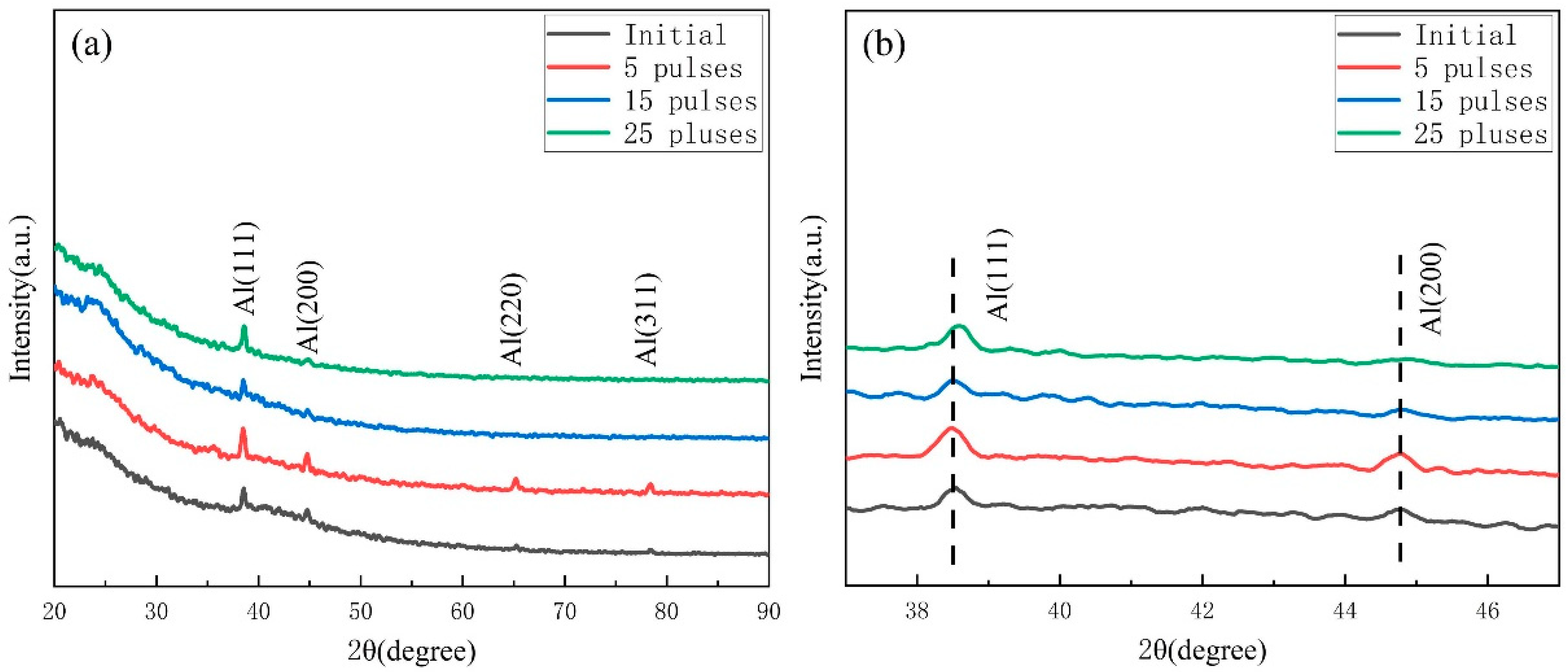

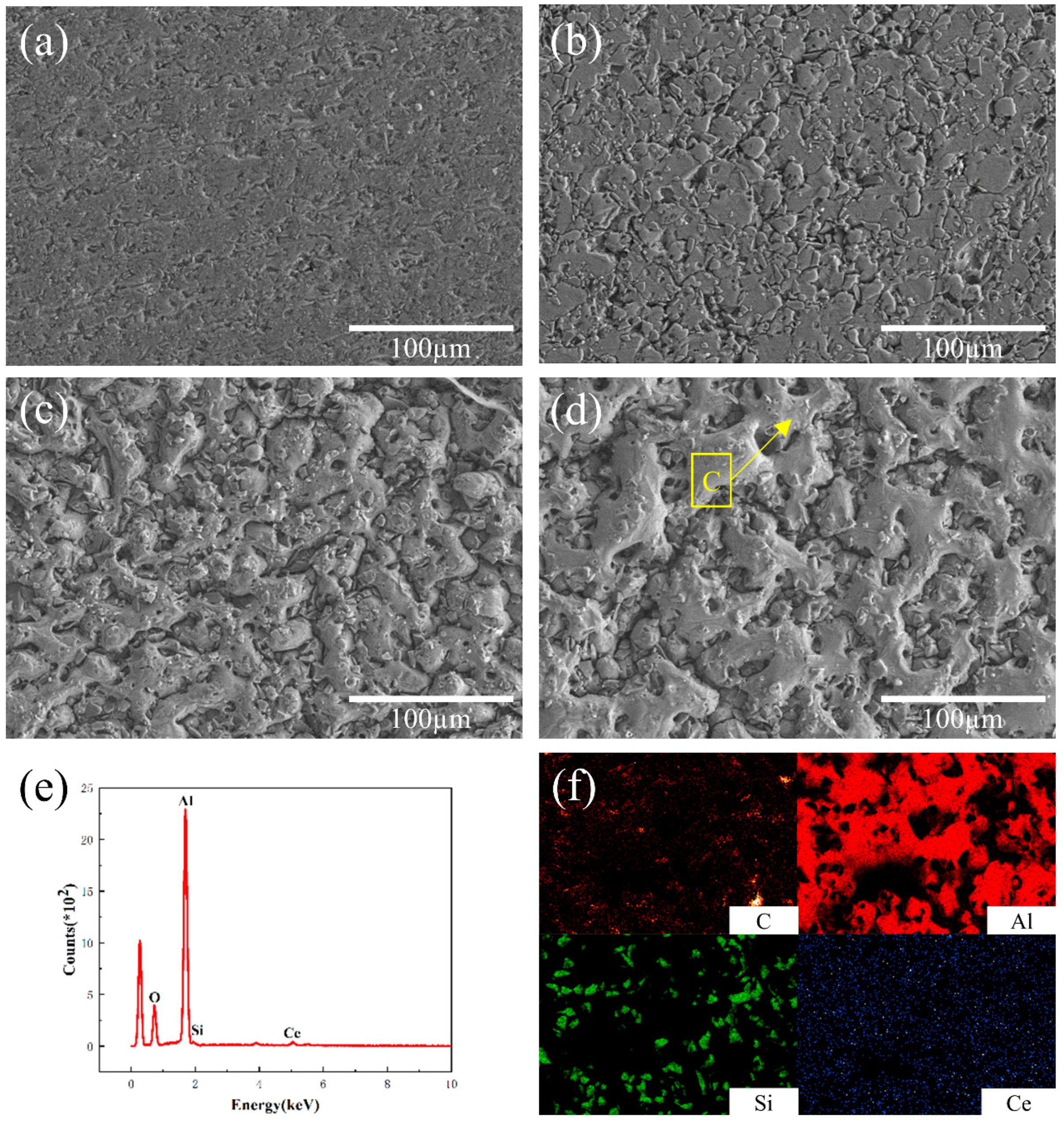
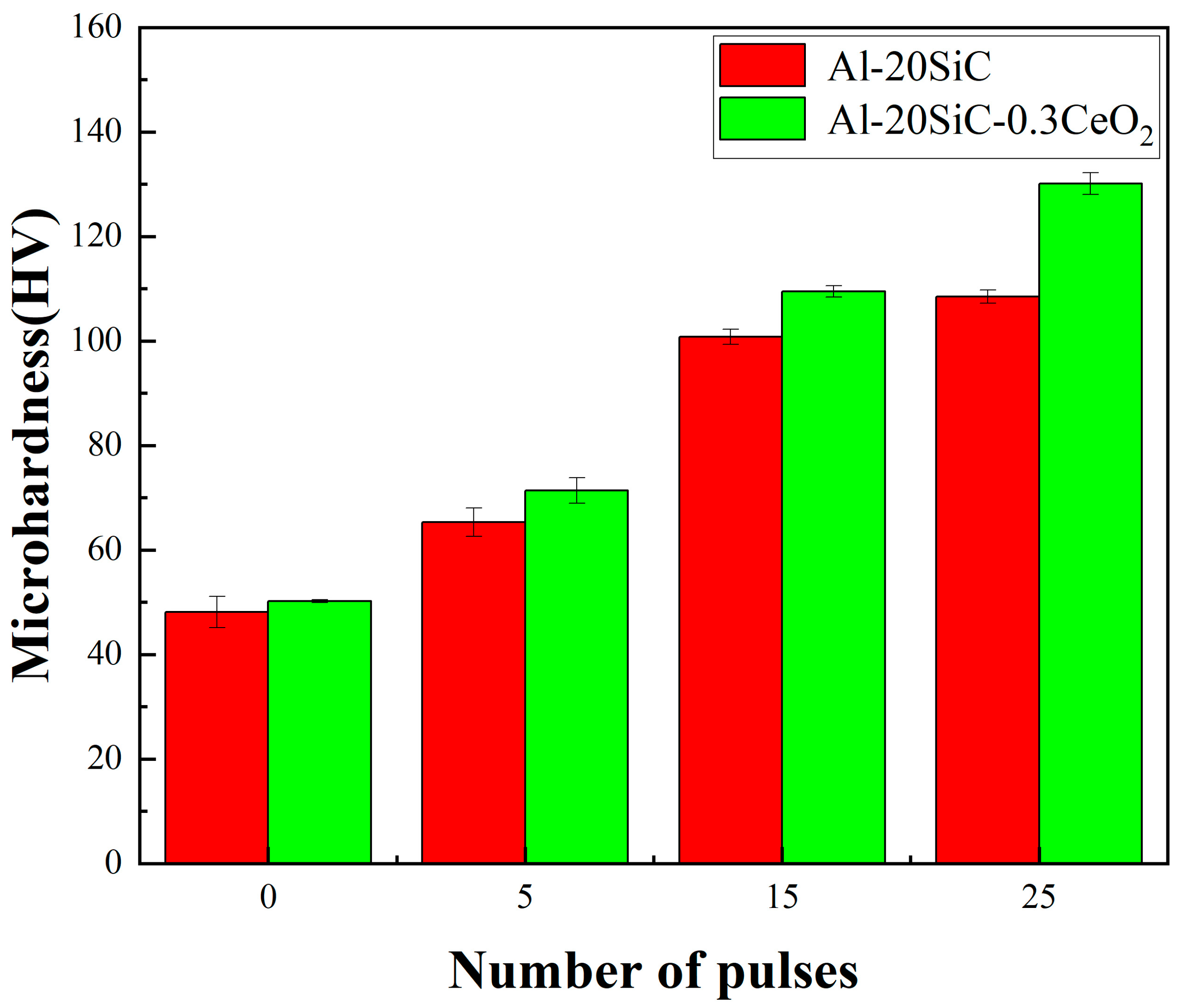
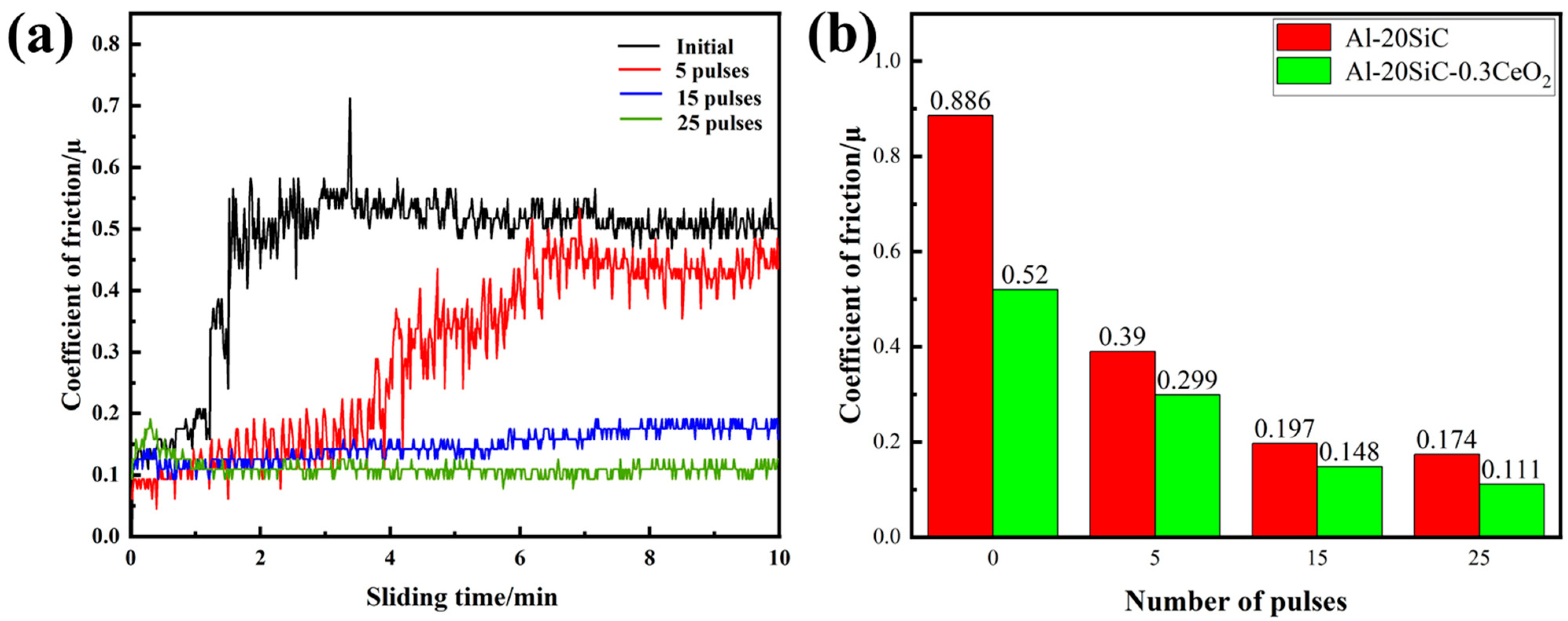

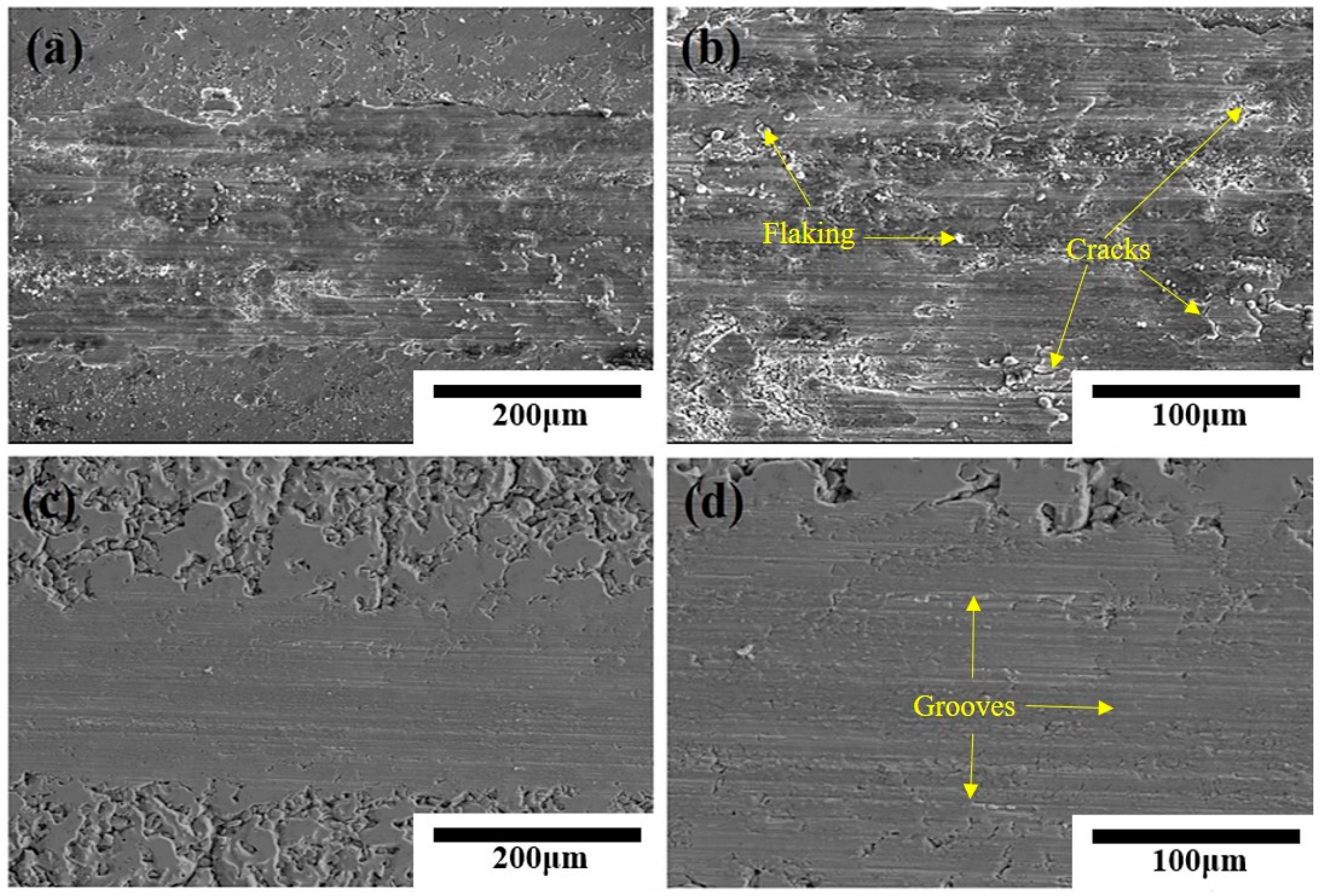
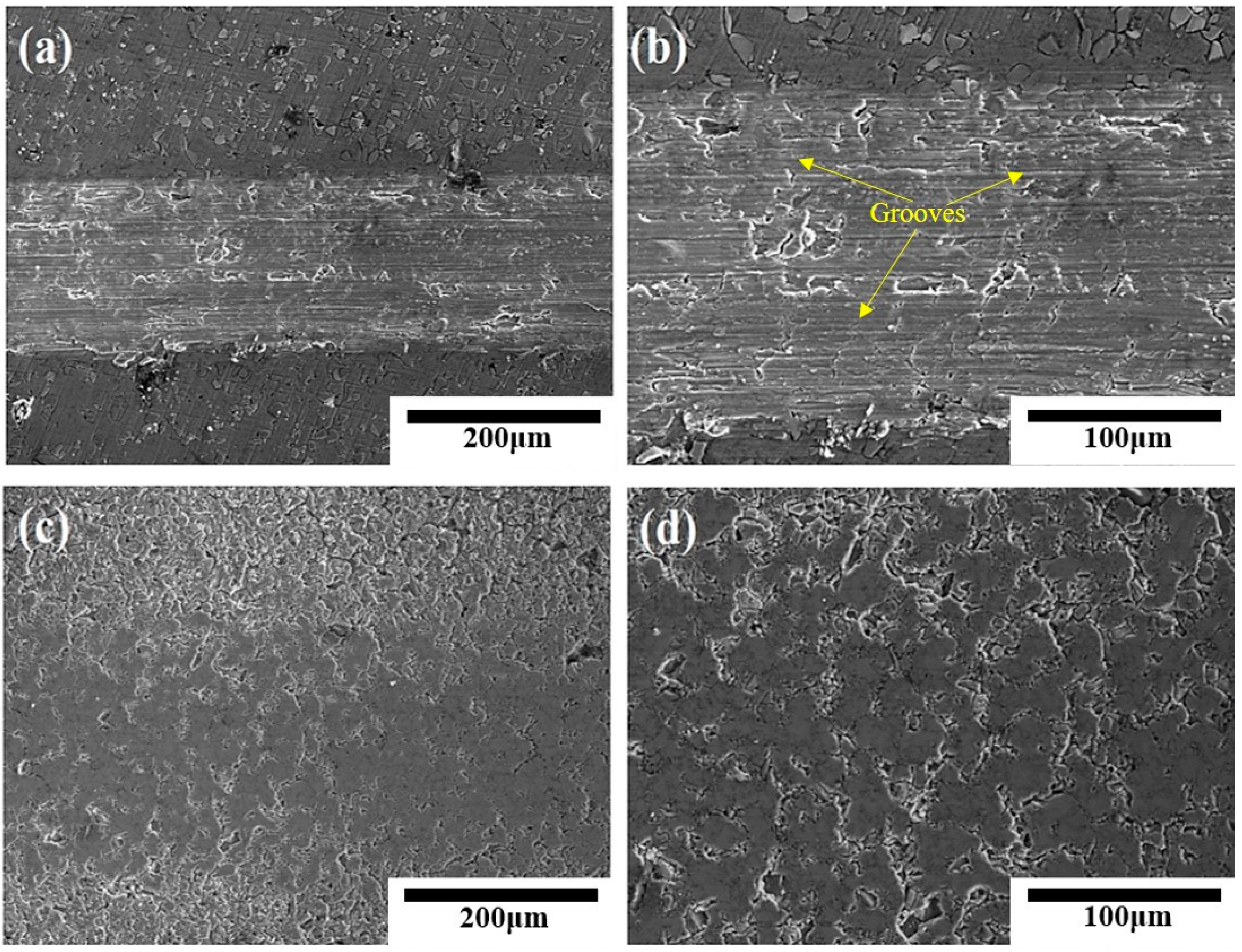
| Powder | Purity/wt.% | Particle Size/µm |
|---|---|---|
| Al | 99.9 wt.% | 20–30 µm |
| SiC | 99.9 wt.% | 1–2 µm |
| CeO2 | 99.9 wt.% | 6–10 µm |
| Acceleration Voltage (kV) | Energy Density (J/cm2) | Pulse Time (μs) | Pulse Frequency (Hz) | Vacuum Level (Pa) |
|---|---|---|---|---|
| 24.5 | 2 | 3 | 0.1 | 6.5 × 10−3 |
Disclaimer/Publisher’s Note: The statements, opinions and data contained in all publications are solely those of the individual author(s) and contributor(s) and not of MDPI and/or the editor(s). MDPI and/or the editor(s) disclaim responsibility for any injury to people or property resulting from any ideas, methods, instructions or products referred to in the content. |
© 2023 by the authors. Licensee MDPI, Basel, Switzerland. This article is an open access article distributed under the terms and conditions of the Creative Commons Attribution (CC BY) license (https://creativecommons.org/licenses/by/4.0/).
Share and Cite
Wang, L.; Gao, B.; Sun, Y.; Zhang, Y.; Hu, L. Effect of High Current Pulsed Electron Beam (HCPEB) on the Organization and Wear Resistance of CeO2-Modified Al-20SiC Composites. Materials 2023, 16, 4656. https://doi.org/10.3390/ma16134656
Wang L, Gao B, Sun Y, Zhang Y, Hu L. Effect of High Current Pulsed Electron Beam (HCPEB) on the Organization and Wear Resistance of CeO2-Modified Al-20SiC Composites. Materials. 2023; 16(13):4656. https://doi.org/10.3390/ma16134656
Chicago/Turabian StyleWang, Lei, Bo Gao, Yue Sun, Ying Zhang, and Liang Hu. 2023. "Effect of High Current Pulsed Electron Beam (HCPEB) on the Organization and Wear Resistance of CeO2-Modified Al-20SiC Composites" Materials 16, no. 13: 4656. https://doi.org/10.3390/ma16134656
APA StyleWang, L., Gao, B., Sun, Y., Zhang, Y., & Hu, L. (2023). Effect of High Current Pulsed Electron Beam (HCPEB) on the Organization and Wear Resistance of CeO2-Modified Al-20SiC Composites. Materials, 16(13), 4656. https://doi.org/10.3390/ma16134656






